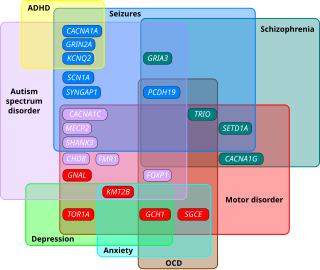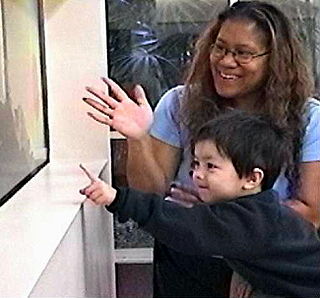Related Research Articles

Asperger syndrome (AS), also known as Asperger's syndrome or Asperger's, is a term formerly used to describe a neurodevelopmental condition characterized by significant difficulties in social interaction and nonverbal communication, along with restricted, repetitive patterns of behavior and interests. Asperger syndrome has been merged with other conditions into autism spectrum disorder (ASD) and is no longer considered a stand-alone diagnosis. It was considered milder than other diagnoses which were merged into ASD due to relatively unimpaired spoken language and intelligence.
Developmental disorders comprise a group of psychiatric conditions originating in childhood that involve serious impairment in different areas. There are several ways of using this term. The most narrow concept is used in the category "Specific Disorders of Psychological Development" in the ICD-10. These disorders comprise developmental language disorder, learning disorders, developmental coordination disorders, and autism spectrum disorders (ASD). In broader definitions, attention deficit hyperactivity disorder (ADHD) is included, and the term used is neurodevelopmental disorders. Yet others include antisocial behavior and schizophrenia that begins in childhood and continues through life. However, these two latter conditions are not as stable as the other developmental disorders, and there is not the same evidence of a shared genetic liability.
In psychology, schizotypy is a theoretical concept that posits a continuum of personality characteristics and experiences, ranging from normal dissociative, imaginative states to extreme states of mind related to psychosis, especially schizophrenia. The continuum of personality proposed in schizotypy is in contrast to a categorical view of psychosis, wherein psychosis is considered a particular state of mind, which the person either has or does not have.

Sensory processing sensitivity (SPS) is a temperamental or personality trait involving "an increased sensitivity of the central nervous system and a deeper cognitive processing of physical, social, and emotional stimuli". The trait is characterized by "a tendency to 'pause to check' in novel situations, greater sensitivity to subtle stimuli, and the engagement of deeper cognitive processing strategies for employing coping actions, all of which is driven by heightened emotional reactivity, both positive and negative".

Autism spectrum disorder (ASD) is a neurodevelopmental disorder that begins in early childhood, persists throughout adulthood, and affects two crucial areas of development: social communication and restricted, repetitive patterns of behavior. There are many conditions comorbid to autism spectrum disorder such as attention-deficit hyperactivity disorder and epilepsy.
The following outline is provided as an overview of and topical guide to autism:
Developmental disability is a diverse group of chronic conditions, comprising mental or physical impairments that arise before adulthood. Developmental disabilities cause individuals living with them many difficulties in certain areas of life, especially in "language, mobility, learning, self-help, and independent living". Developmental disabilities can be detected early on and persist throughout an individual's lifespan. Developmental disability that affects all areas of a child's development is sometimes referred to as global developmental delay.

The University of North Carolina TEACCH Autism Program creates and disseminates community-based services, training programs, and research for individuals of all ages and skill levels with autism spectrum disorder (ASD), to enhance the quality of life for them and their families across the lifespan.
Sensory overload occurs when one or more of the body's senses experiences over-stimulation from the environment.

Autism therapies include a wide variety of therapies that help people with autism, or their families. Such methods of therapy seek to aid autistic people in dealing with difficulties and increase their functional independence.

Self-stimulatory behavior, also known as "stimming" and self-stimulation, is the repetition of physical movements, sounds, words, moving objects, or other behaviors. Such behaviors are found to some degree in all people, especially those with developmental disabilities such as ADHD, as well as autistic people. People diagnosed with sensory processing disorder are also known to potentially exhibit stimming behaviors.
Social Stories were devised as a tool to help autistic individuals better understand the nuances of interpersonal communication so that they could "interact in an effective and appropriate manner". Although the prescribed format was meant for high functioning people with basic communication skills, the format was adapted substantially to suit individuals with poor communication skills and low level functioning. The evidence shows that there has been minimal improvement in social interaction skills. However, it is difficult to assess whether the concept would have been successful if it had been carried out as designed.

Classic autism, also known as childhood autism, autistic disorder, (early) infantile autism, infantile psychosis, Kanner's autism, Kanner's syndrome, or (formerly) just autism, is a neurodevelopmental condition first described by Leo Kanner in 1943. It is characterized by atypical and impaired development in social interaction and communication as well as restricted, repetitive behaviors, activities, and interests. These symptoms first appear in early childhood and persist throughout life.
Autism, also called autism spectrum disorder (ASD) or autism spectrum condition (ASC), is a neurodevelopmental disorder marked by deficits in reciprocal social communication and the presence of restricted and repetitive patterns of behavior. Other common signs include difficulty with social interaction, verbal and nonverbal communication, along with perseverative interests, stereotypic body movements, rigid routines, and hyper- or hyporeactivity to sensory input. Autism is clinically regarded as a spectrum disorder, meaning that it can manifest very differently in each person. For example, some are nonspeaking, while others have proficient spoken language. Because of this, there is wide variation in the support needs of people across the autism spectrum.

Autism-friendly means being aware of social engagement and environmental factors affecting people on the autism spectrum, with modifications to communication methods and physical space to better suit individual's unique and special needs.
The rapid prompting method (RPM) is a pseudoscientific technique that attempts to aid communication by people with autism or other disabilities to communicate through pointing, typing, or writing. Also known as Spelling to Communicate, it is closely related to the scientifically discredited technique facilitated communication (FC). Practitioners of RPM have failed to assess the issue of message agency using simple and direct scientific methodologies, saying that doing so would be stigmatizing and that allowing scientific criticisms of the technique robs people with autism of their right to communicate. The American Speech-Language-Hearing Association has issued a statement opposing the practice of RPM.

Sensory processing disorder is a condition in which multisensory input is not adequately processed in order to provide appropriate responses to the demands of the environment. Sensory processing disorder is present in many people with dyspraxia, autism spectrum disorder and attention deficit hyperactivity disorder. Individuals with SPD may inadequately process visual, auditory, olfactory (smell), gustatory (taste), tactile (touch), vestibular (balance), proprioception, and interoception sensory stimuli.
Nonverbal autism, also called nonspeaking autism, is a subset of autism spectrum disorder where the person does not learn how to speak. One study has shown that 64% of autistic children who are nonverbal at age 5 are still nonverbal 10 years later.
Caetextia is a term and concept first coined by psychologists Joe Griffin and Ivan Tyrrell to describe a chronic disorder that manifests as a context blindness in people on the autism spectrum. It was specifically used to designate the most dominant manifestation of autistic behaviour in higher-functioning individuals. Griffin and Tyrell also suggested that caetextia "is a more accurate and descriptive term for this inability to see how one variable influences another, particularly at the higher end of the spectrum, than the label of 'Asperger's syndrome'".
The diagnosis of autism is based on a person's reported and directly observed behavior. There are no known biomarkers for autism spectrum conditions that allow for a conclusive diagnosis.
References
Notes
- 1 2 McDonnell, Reeves, Johnson & Lane, 1998, p. 164
- ↑ McDonnell, McEvoy & Dearden, (1994)
- ↑ McDonnell, (2010)
- ↑ Corbett, B.A. and Simon, D. (2013)
- ↑ Richetin, J. and Richardson, D.S. (2007)
- 1 2 McDonnell et al., (2015)
- ↑ Hutt, Hutt, Lee and Ounsted, 1964
- ↑ Althaus, van Roon, Mulder, Mulder, Aarnoudse and Minderaa 2004
- ↑ Hirstein Iversen and Ramachandran 2001
- ↑ van Engeland, Roelofs, Verbaten and Slangen, 1991
- ↑ Goodwin, et al., (2006)
- ↑ Hirstein, et al., (2001)
- 1 2 Rogers and Ozonoff, 2005
- ↑ Garey, Goodwillie, Frohlich, Morgan, Gustafsson, Smithies, Korach, Ogawa and Pfaff, 2003
- ↑ Rimland, 1964; DesLauriers and Carlson, 1969
- ↑ Kinsbourne, 1980
- ↑ Shore, 2003; O'Neill and Jones, 1997
- 1 2 3 Liss, Saulnier, Fein and Kinsbourne, 2006
- ↑ Howlin, 1998; Groden, Cautela, Prince and Berryman, 1994
- ↑ Lazarus and Folkman (1984)
- ↑ Frith, 2003
Resources
- Althaus, M.; van Roon, A.M.; Mulder, L.J.M.; Mulder, G.; Aarnoudse, C.C.; Minderaa, R.B. (2000). Autonomic Response Patterns Observed during the Performance of an attention Demanding Task in two groups of Children with Autistic-Type Difficulties in Social Adjustment. Psychophysiology, 41, 893–904.
- Corbett, B.A.; Simon, D. (2013). Adolescence, Stress and Cortisol in Autism Spectrum Disorders. Open Access Autism, 1(1), 2.
- Deslauriers, A.M.; Carlson, C.F. (1969). Your child is asleep: Early infantile autism. Homewood, IL: Dorsey Press;
- Frith, U. (2003). Autism Explaining the Enigma. (2nd Edition) Oxford: Blackwell.
- Garey, J.; Goodwillie, A.; Frohlich, J.; Morgan, M.; Gustaffson, J.A.; Smithies, O.; Korach, K.S.; Ogawa, S.; Pfaff, D.W. (2003) Genetic Contributions to Generalized Arousal of Brain and Behavior. Proceedings of the National Academy of Sciences of the United States of America, 100, 11019–11022.
- Goodwin, M.S.; Groden, J.; Velicer, W.F.; Lipsitt, L.P.; Grace Baron, M.; Hofmann, S.G.; Groden, G. (2006). Cardiovascular Arousal in Individuals With Autism. Focus on Autism and Other Developmental Disabilities, 21, 100–123.
- Groden, J.; Cautela, J.; Prince, S.; Berryman, J. (1994). The Impact of Stress and Anxiety on Individuals with Autism and other Developmental Disabilities. In E. Schopler and G. Mesibov (Eds.) Behavior Issues and Autism. New York, Plenum Publishing.
- Hirstein, W.; Iversen, P.; Ramachandran, V.S. (2001). Autonomic Responses of Autistic Children to People and Objects. Proceedings: Biological Sciences
- Howlin, P. (1998). Children with Autism and Aspergers Syndrome: A Guide for Practitioners and Carers. Chichester: Wiley.
- Hutt, C.; Hutt, S.J.; Lee, D.; Ounstead, C. (1964). Arousal and Childhood Autism. Nature, 204, 908–909.
- Kinsbourne, M. (1980). Do Repetitive Movement Patterns in Children and Animals Serve a Dearousing Function? Developmental and Behavioral Paediatrics, 1, 39–42.
- Lazarus, R.S.; Folkman, S. (1984). Stress, Appraisal, and Coping. New York: Springer.
- Liss, M.; Saulnier, C.; Fein, D; Kinsbourne, M. (2006). Sensory and Attention Abnormalities in Autistic Spectrum disorders. Autism, 10, 155–172
- McDonnell, A.A.; Waters, T.; Jones D. (2002). Low Arousal Approaches in the Management of Challenging Behaviours. In D. Allen (Ed) Ethical approaches to physical interventions: Responding to Challenging behaviours in people with Intellectual Disabilities. Plymouth: BILD, pp. 104–113.
- McDonnell, A.A.; McEvoy, J.; Dearden, R.L. (1994). Coping with Violent Situations in the Caring Environment. In T. Wykes (Ed) Violence and health care professionals. London: Chapman and Hall, pp. 189–206.
- McDonnell, A.A.; Reeves, S.; Johnson, A.; Lane, A. (1998). Management Challenging Behaviours in an Adult with Learning Disabilities: the Use of Low Arousal. Behavioural and Cognitive Psychotherapy, 26, 163–171.
- McDonnell, A.A. (2010). Managing Aggressive Behaviour in Care Settings: Understanding and Applying Low Arousal Approaches. Chichester: Wiley-Blackwell.
- McDonnell, A.A.; McCreadie, M.; Mills, R.; Deveau, R.; Anker, R.; Hayden, J. (2015). The Role of Physiological Arousal in the Management of Challenging Behaviours in Individuals with Autism Spectrum Disorders. Research in Developmental Disabilities, 36C, 311-322.
- McDonnell, A.A. (2019). The Reflective Journey: A Practitioner's Guide to the Low Arousal Approach. UK: Studio 3 Publications.
- O'Neill, M.; Jones, R.S.P. (1997). Sensory Perceptual Abnormalities in Autism: A Case for More Research. Journal of Autism and Developmental Disorders, 27(3), 283–293.
- Richetin, J.; Richardson, D.S. (2007). Automatic Processes and Individual Differences in Aggressive Behaviour. Aggression and Violent Behaviour, 13, 423-430.
- Rimland, B. (1964). Infantile autism, New York: Appleton Century Crofts.
- Rogers, S.J.; Ozonoff, S. (2005). What Do We Know About Sensory Dysfunction in Autism? A Critical Review of the Empirical Evidence. Journal of Child Psychology and Psychiatry, 46, 1255–1268.
- Shore S. (2003). Beyond the Wall: Personal Experiences with Autism and Asperger Syndrome: Autism Asperger publishing company.
- Van Engeland, H.; Roelofs, J.W.; Verbaten, M.N.; Slangen, J.L. (1991). Abnormal Electrodermal Reactivity to Novel Visual Stimuli in Autistic Children. Psychiatry Research, 38, 27–38.